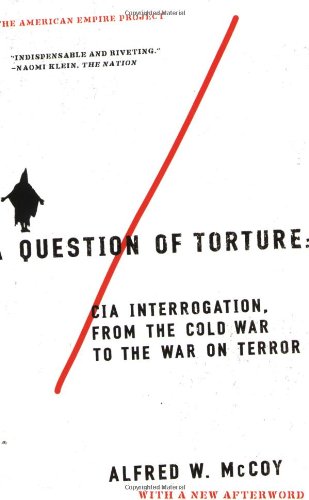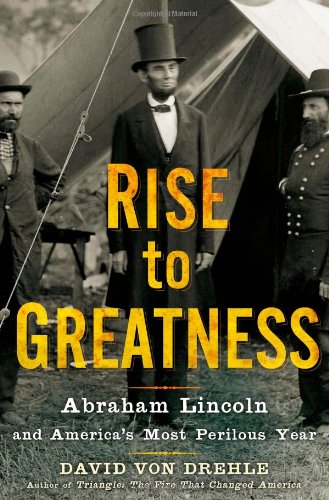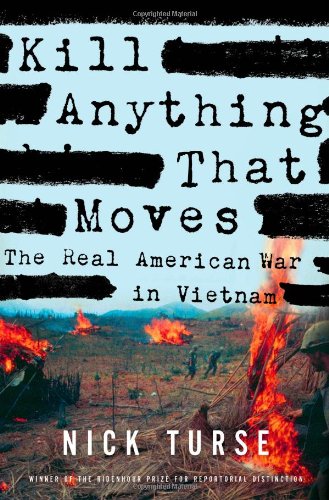Get Free Ebook A Question of Torture: CIA Interrogation, from the Cold War to the War on Terror (American Empire Project), by Alfred McCoy
A Question Of Torture: CIA Interrogation, From The Cold War To The War On Terror (American Empire Project), By Alfred McCoy. The industrialized innovation, nowadays assist everything the human requirements. It consists of the day-to-day tasks, jobs, workplace, enjoyment, and a lot more. Among them is the wonderful internet connection as well as computer system. This condition will alleviate you to support one of your hobbies, reviewing habit. So, do you have prepared to read this e-book A Question Of Torture: CIA Interrogation, From The Cold War To The War On Terror (American Empire Project), By Alfred McCoy now?

A Question of Torture: CIA Interrogation, from the Cold War to the War on Terror (American Empire Project), by Alfred McCoy

Get Free Ebook A Question of Torture: CIA Interrogation, from the Cold War to the War on Terror (American Empire Project), by Alfred McCoy
Find much more experiences and also expertise by reviewing guide qualified A Question Of Torture: CIA Interrogation, From The Cold War To The War On Terror (American Empire Project), By Alfred McCoy This is a book that you are trying to find, right? That corrects. You have concerned the best website, then. We consistently give you A Question Of Torture: CIA Interrogation, From The Cold War To The War On Terror (American Empire Project), By Alfred McCoy and also the most preferred e-books on the planet to download and install as well as delighted in reading. You could not neglect that seeing this collection is a purpose and even by unexpected.
Positions now this A Question Of Torture: CIA Interrogation, From The Cold War To The War On Terror (American Empire Project), By Alfred McCoy as one of your book collection! Yet, it is not in your bookcase collections. Why? This is guide A Question Of Torture: CIA Interrogation, From The Cold War To The War On Terror (American Empire Project), By Alfred McCoy that is given in soft file. You can download the soft data of this amazing book A Question Of Torture: CIA Interrogation, From The Cold War To The War On Terror (American Empire Project), By Alfred McCoy now and also in the link supplied. Yeah, various with the other people which search for book A Question Of Torture: CIA Interrogation, From The Cold War To The War On Terror (American Empire Project), By Alfred McCoy outside, you can obtain less complicated to posture this book. When some individuals still stroll right into the store and also search the book A Question Of Torture: CIA Interrogation, From The Cold War To The War On Terror (American Empire Project), By Alfred McCoy, you are below only remain on your seat and obtain guide A Question Of Torture: CIA Interrogation, From The Cold War To The War On Terror (American Empire Project), By Alfred McCoy.
While the other people in the store, they are not sure to find this A Question Of Torture: CIA Interrogation, From The Cold War To The War On Terror (American Empire Project), By Alfred McCoy straight. It may require more times to go shop by shop. This is why we suppose you this site. We will supply the very best method and also reference to obtain guide A Question Of Torture: CIA Interrogation, From The Cold War To The War On Terror (American Empire Project), By Alfred McCoy Also this is soft file book, it will certainly be ease to bring A Question Of Torture: CIA Interrogation, From The Cold War To The War On Terror (American Empire Project), By Alfred McCoy any place or save in your home. The difference is that you could not require move the book A Question Of Torture: CIA Interrogation, From The Cold War To The War On Terror (American Empire Project), By Alfred McCoy area to place. You may require just copy to the various other gadgets.
Currently, reading this spectacular A Question Of Torture: CIA Interrogation, From The Cold War To The War On Terror (American Empire Project), By Alfred McCoy will be easier unless you get download the soft data below. Merely right here! By clicking the link to download and install A Question Of Torture: CIA Interrogation, From The Cold War To The War On Terror (American Empire Project), By Alfred McCoy, you could begin to get the book for your very own. Be the initial proprietor of this soft documents book A Question Of Torture: CIA Interrogation, From The Cold War To The War On Terror (American Empire Project), By Alfred McCoy Make difference for the others and obtain the first to progression for A Question Of Torture: CIA Interrogation, From The Cold War To The War On Terror (American Empire Project), By Alfred McCoy Here and now!

"An indispensable and riveting account" of the CIA's development and use of torture, from the cold war to Abu Ghraib and beyond (Naomi Klein, The Nation)
In this revelatory account of the CIA's fifty-year effort to develop new forms of torture, historian Alfred W. McCoy locates the deep roots of recent scandals at Abu Ghraib and Guantánamo in a long-standing, covert program of interrogation. A Question of Torture investigates the CIA's practice of "sensory deprivation" and "self-inflicted pain," in which techniques including isolation, hooding, hours of standing, and manipulation of time assault the victim's senses and destroy the basis of personal identity. McCoy traces the spread of these practices across the globe, from Vietnam to Iran to Central America, and argues that after 9/11, psychological torture became the weapon of choice in the CIA's global prisons, reinforced by "rendition" of detainees to "torture-friendly" countries. Finally, McCoy shows that information extracted by coercion is worthless, making a strong case for the FBI's legal methods of interrogation.
Scrupulously documented and grippingly told, A Question of Torture is a devastating indictment of inhumane practices that have damaged America's laws, military, and international standing.
- Sales Rank: #550441 in Books
- Brand: McCoy, Alfred W.
- Published on: 2006-12-26
- Released on: 2006-12-26
- Original language: English
- Number of items: 1
- Dimensions: 8.50" h x .72" w x 5.50" l, .95 pounds
- Binding: Paperback
- 320 pages
From The New Yorker
From the start of the Cold War to the early nineteen-sixties, the C.I.A. spent billions of dollars developing psychological tools for interrogation. The agency cast a wide net, funding a Canadian study that involved administering electric shocks to subjects in drug-induced comas, and recruiting people like Kurt Plotner, a Nazi scientist who, in his search for a truth serum, had tested mescaline on Jewish prisoners at Dachau. The eventual conclusion was that cheap, simple methods (for example, enforced standing) worked best, and were also more acceptable to the public than outright physical violence. McCoy skillfully traces the use of these methods from the Phoenix program in Vietnam—which was designed to ferret out high-level Vietcong, although of the more than twenty thousand people it killed most were civilians—to the actions of agency-trained secret police in Honduras in the nineteen-eighties, and the treatment of hooded detainees at Abu Ghraib.
Copyright © 2006 The New Yorker
From Booklist
Current events have precipitated a number of recent books connecting executive-branch policy makers with Abu Ghraib and other torture scandals, and McCoy is not the first author to argue that American use of torture in intelligence gathering has been deliberate and systematic rather than accidental. This book is unique, however, in connecting the dots all the way back to early cold war mind-control research, reminding readers that the CIA has been an innovator in modern torture methods. Incorporating simple yet brutally effective techniques of psychological manipulation involving isolation, disorientation, and destruction of personal identity, McCoy argues, the modern CIA interrogation manual is premised on university and army research into the psychology of coercion. As in his earlier work on CIA complicity in the global heroin trade, McCoy is adept at tracing the inertia of government practice; his research on the effect of torture on the Philippine armed forces likewise shows policy in practice and demonstrates that psychological torture is at least as scarring as thumbscrews. Timely and compelling. Brendan Driscoll
Copyright © American Library Association. All rights reserved
About the Author
Alfred W. McCoy is a professor of history at the University of
Wisconsin-Madison. He is the author of numerous books and articles, including The Politics of Heroin in Southeast Asia and Closer Than Brothers.
Most helpful customer reviews
74 of 78 people found the following review helpful.
An invaluable book
By James Lowell
By providing a historical context for understanding recent revelations of U.S. government-perpetrated atrocities, McCoy convincingly unmasks the lie that Abu Ghraib is a mere aberration. In doing so, he shows that those in the United States who are serious about human rights have to address the ugly essence of U.S. foreign policy and practice rather than problems misperceived as short-term and exceptional. The evidence McCoy presents is overwhelming, and his analysis insightful.
35 of 36 people found the following review helpful.
A Call For Soul Searching
By Mike Hopping
A Question Of Torture is a penetrating study of fifty years of United States involvement in torture research, practice, and propagation. Dr. McCoy, Professor of History at the University of Wisconsin-Madison, isn't neutral on the subject. But his book isn't a doctrinaire rejection of cruel, inhuman, or degrading treatment. Nor is it a compendium of tragic personal case studies. Instead, he takes advantage of his misgivings about torture to delve into its history, the whys and wherefores of state-sponsored torture, and the demonstrable results of these practices. The work he has produced is as illuminating as it is easy to read. And, supported by sixty pages of sources and notes, the book should prove useful to readers with academic interests as well.
McCoy, whose previous works include a landmark study of the heroin trade, begins with an overview of torture and its usages through the past two thousand years. Then he takes us to the early days of the Cold War and a concerted US attempt to increase intelligence yields through mind control techniques. Early on, the emphasis was on electroshock, hypnosis, psychosurgery, and drugs, including the infamous use of LSD on unsuspecting soldiers and civilians. But the results were disappointing. Researchers soon learned that sensory disorientation (hooding, manipulation of sleep, etc.) and "self-inflicted pain" (for example forcing an uncooperative subject to stand for many hours with arms outstretched) were more effective means of breaking prisoners. Augmented by fears of physical abuse, sexual humiliation, and other psychological attacks on personal and cultural identity, our government produced exactly the system on display in the Abu Ghraib abuse photographs.
But Iraq is hardly our country's maiden voyage into the application of torture on an industrial scale. During the Vietnam War, Project Phoenix, a joint CIA and Vietnamese counter-insurgency operation, resulted in the torture of tens of thousands of suspected Viet Cong and sympathizers and caused the deaths of more than 26,000 of them. In Latin America, US operatives trained and abetted right-wing military and paramilitary personnel during the dirty wars of the 1970s and 80s. We also shared our expertise with the shah of Iran's secret police and the Filipino military during the Marcos years. McCoy reports that Philippine officers trained in these "extralegal" methods, went on to lead RAM, one of the more persistent groups to seek the violent overthrow of Marcos and also his successor, Corazon Aquino.
McCoy recounts the political moves that paved the way for prisoner abuse to become US policy during the war on terror. And he documents the inability or failure of judicial, military, and congressional authorities to hold high-ranking personnel in the executive branch, CIA, military, or behavioral sciences accountable. In such an environment, he believes we should expect a continuing series of revelations concerning direct and indirect US sponsorship of torture.
Does torture work? McCoy finds little specific factual evidence to suggest the "ticking time bomb" rationale for torture on a small scale has merit. The Manila police learned of a plot to destroy several airliners from Abdul Hakim Murad's laptop computer, not from the sixty-seven days of torture that followed. Israeli claims of many suicide bombings prevented by harsh interrogation techniques boil down to one documented case. Mass torture, such as that practiced by the French in Algeria, Project Phoenix in Vietnam, the right-wing Latin American dictatorships of the Pinochet era, the shah's Iran, and the Marcos Philippines did win battles. But, in each case, the popular reaction to it contributed to losing the war.
If the "ticking time bomb" justification for torture doesn't correspond to experience and mass torture loses wars, why do governments resort to it? The reason, McCoy concludes, is not rational and not very different from kicking the dog after being barked at by the boss. "In sum, the powerful often turn to torture in times of crisis, not because it works but because it salves their fears and insecurities with the psychic balm of empowerment."
A Question Of Torture is a lucid exposure of an evil open secret and of the skeins of denial and justification swaddling it. This book deserves a wide readership and should, but probably won't, stimulate some serious national soul searching.
32 of 35 people found the following review helpful.
This is Our Government
By Douglas S. Wood
Alfred McCoy, a distinguished professor of history at the University of Wisconsin, has long been a thorn in the side of the CIA. In the pages of this brief book McCoy traces the history of modern torture techniques as developed and used by the CIA. The book demonstrates that the Abu Ghraib abuses have roots far beyond the Bush years. The techniques used there are standard operating procedure.
Sensory deprivation, self-infiction of pain, and assault on the cultural mores of the victim are the hallmarks of the techniques. Read this book and then take one look at the infamous Abu Ghraib pictures and you will understand with certainty that the responsibility goes well beyond Lynndie England and the prison guard grunts. They did not come up with these techniques.
McCoy briefly relates that the US historically engaged in systematic torture in the Vietnam Phoenix program and taught Central American governments the CIA methods, to name just two examples. This history was largely ignored in discussions of Abu Ghraib as some commentators simply refused to believe that Americans would do such things.
But does torture work? And if it does, should we use it?
With respect to the efficacy of torture, McCoy quotes a 4th century C.E. Roman legal scholar Ulpian: "the strong will resist and the weak will say anything to end the pain." McCoy also destroys the silly hypotheses about the atomic bomb in Times Square used to justify torture.
McCoy has explained why we, in whose name this torture is performed, should oppose it:
"There's an absolute ban on torture for a very good reason. Torture taps into the deepest recesses, unexplored recesses of human consciousness, where creation and destruction coexist, where the infinite human capacity for kindness and infinite human capacity for cruelty coexist, and it has a powerful perverse appeal, and once it starts, both the perpetrators and the powerful who order them, let it spread, and it spreads out of control."
Highly recommended.
A Question of Torture: CIA Interrogation, from the Cold War to the War on Terror (American Empire Project), by Alfred McCoy PDF
A Question of Torture: CIA Interrogation, from the Cold War to the War on Terror (American Empire Project), by Alfred McCoy EPub
A Question of Torture: CIA Interrogation, from the Cold War to the War on Terror (American Empire Project), by Alfred McCoy Doc
A Question of Torture: CIA Interrogation, from the Cold War to the War on Terror (American Empire Project), by Alfred McCoy iBooks
A Question of Torture: CIA Interrogation, from the Cold War to the War on Terror (American Empire Project), by Alfred McCoy rtf
A Question of Torture: CIA Interrogation, from the Cold War to the War on Terror (American Empire Project), by Alfred McCoy Mobipocket
A Question of Torture: CIA Interrogation, from the Cold War to the War on Terror (American Empire Project), by Alfred McCoy Kindle






